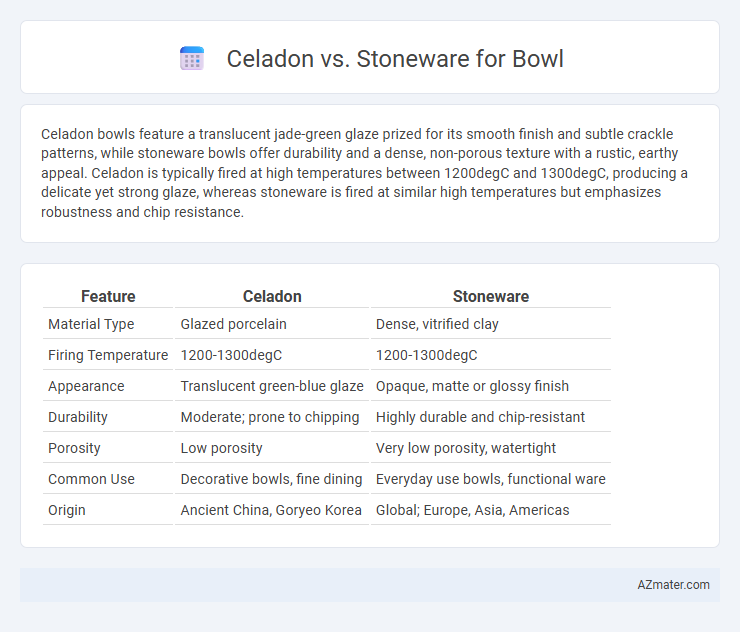Celadon bowls feature a translucent jade-green glaze prized for its smooth finish and subtle crackle patterns, while stoneware bowls offer durability and a dense, non-porous texture with a rustic, earthy appeal. Celadon is typically fired at high temperatures between 1200degC and 1300degC, producing a delicate yet strong glaze, whereas stoneware is fired at similar high temperatures but emphasizes robustness and chip resistance.
Table of Comparison
| Feature | Celadon | Stoneware |
|---|---|---|
| Material Type | Glazed porcelain | Dense, vitrified clay |
| Firing Temperature | 1200-1300degC | 1200-1300degC |
| Appearance | Translucent green-blue glaze | Opaque, matte or glossy finish |
| Durability | Moderate; prone to chipping | Highly durable and chip-resistant |
| Porosity | Low porosity | Very low porosity, watertight |
| Common Use | Decorative bowls, fine dining | Everyday use bowls, functional ware |
| Origin | Ancient China, Goryeo Korea | Global; Europe, Asia, Americas |
Introduction to Celadon and Stoneware Bowls
Celadon bowls are renowned for their translucent jade-green glaze, originating from ancient Chinese pottery techniques that emphasize refinement and subtle color variations. Stoneware bowls, crafted from dense clay fired at high temperatures between 1,100degC and 1,300degC, offer durability and resistance to chipping, making them ideal for everyday use. Both materials balance aesthetics and functionality, with celadon prized for its delicate beauty and stoneware for its robustness.
Historical Background of Celadon and Stoneware
Celadon originated in ancient China during the Eastern Han Dynasty, prized for its jade-like green glaze created through iron oxide firing techniques. Stoneware, dating back to prehistoric times across various cultures, emerged as a durable, non-porous ceramic fired at high temperatures between 1,100degC and 1,300degC. Both materials reflect significant advancements in ceramic technology, with celadon symbolizing refined artistry and stoneware known for its robustness and everyday utility.
Material Composition and Firing Techniques
Celadon bowls are crafted from porcelain or high-fired stoneware with a distinctive iron oxide glaze that creates a translucent, jade-like finish during a reduction firing process typically between 1200degC and 1300degC. Stoneware bowls are made from dense, non-porous clay fired at high temperatures ranging from 1200degC to 1300degC in an oxidation or reduction atmosphere, resulting in a durable, opaque ceramic body. The firing technique for celadon emphasizes oxygen reduction to develop its signature glaze color, while stoneware firing focuses on achieving vitrification and strength without the translucent glaze effect.
Aesthetic Differences: Color, Texture, and Glaze
Celadon bowls showcase a translucent, pale green glaze achieved through iron oxide in the glaze firing, offering a smooth, glass-like texture with subtle gradient effects that emphasize delicate craftsmanship. Stoneware bowls feature earthy tones ranging from warm browns to deep grays, with a more robust, matte or satin finish that highlights natural clay textures and often accepts thicker, varied glazes. The aesthetic contrast lies in celadon's refined translucency and delicate color shifts compared to stoneware's sturdy, rustic appearance and tactile surface.
Durability and Everyday Use
Celadon bowls, known for their elegant glaze and subtle translucency, offer moderate durability suitable for gentle everyday use but may chip more easily compared to stoneware. Stoneware bowls are fired at higher temperatures, resulting in a dense, non-porous surface that provides exceptional strength and resistance to chipping, making them ideal for daily, heavy-duty use. Both materials excel in heat retention, but stoneware's robustness ensures longer-lasting performance under frequent handling and washing.
Heat Retention and Food Safety
Celadon bowls, known for their glazed, non-porous surface, offer excellent food safety by preventing bacteria absorption and are generally safe for microwave and dishwasher use. Stoneware bowls excel in heat retention due to their dense, fired clay composition, keeping food warm longer compared to celadon. Both materials are durable, but stoneware's superior thermal mass makes it ideal for serving hot dishes while celadon's smooth glaze enhances hygiene and ease of cleaning.
Price and Accessibility
Celadon bowls typically cost more than stoneware due to their intricate glazing process and historical significance, making them a premium choice for collectors and enthusiasts. Stoneware bowls are widely available and budget-friendly, offering durability and a variety of styles suitable for everyday use. The accessibility of stoneware in most retail outlets makes it an economical option compared to the relatively scarce and higher-priced celadon pieces.
Maintenance and Care Tips
Celadon bowls require gentle handling and mild detergents to preserve their delicate glaze and prevent cracks, avoiding sudden temperature changes that could cause thermal shock. Stoneware bowls are more durable and resistant to chips and scratches but still benefit from avoiding abrasive cleaners that can dull the surface. Both materials should be hand-washed and dried thoroughly to maintain their finish and longevity.
Popular Uses and Culinary Applications
Celadon bowls, prized for their translucent glaze and subtle green hues, are widely used in East Asian cuisine for serving soups, noodles, and delicate dishes due to their elegant presentation and non-reactive surface. Stoneware bowls, known for their durability and heat retention, are favored for hearty meals like stews, salads, and baked dishes, making them ideal for both oven use and casual dining. The choice between celadon and stoneware often depends on the desired aesthetic and the thermal properties needed for specific culinary applications.
Choosing Between Celadon and Stoneware Bowls
Choosing between celadon and stoneware bowls depends on aesthetic preference and functional needs; celadon bowls are renowned for their translucent glaze with subtle greenish hues and smooth texture, offering an elegant, classic appearance. Stoneware bowls provide durability and versatility, featuring a thicker, more opaque body and a natural, earthy look that withstands everyday use and thermal shock. For decorative purposes, celadon's refined finish appeals, while stoneware is ideal for practical, heavy-duty kitchen applications.

Infographic: Celadon vs Stoneware for Bowl
 azmater.com
azmater.com